This is the ninth in a series of posts I am writing about the game of hypergammon. The previous posts are [Hyper 01], [Hyper 02], [Hyper 03], [Hyper 04], [Hyper 05], [Hyper 06], [Hyper 07], and [Hyper 08].
The term “contact” is well known to backgammon players. When you lose contact with your opponent, it means all of your checkers have moved past all of your opponent’s checkers and the game has transitioned into a “pure race” with no more hitting or blocking.
But what does contact mean exactly? Let’s look at some possible definitions.
Overlapping Contact
A formula I use in computer programming is the “overlap formula.” It works by taking the point number of black’s farthest-back checker and adding to it the point number of white’s farthest-back checker. If the total is greater than 25, then the position is deemed to have contact.
Here is an example:
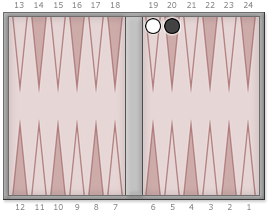 | 20 v 6: Black to roll |
Both players have one checker remaining, black on his 20 point and white on his 6 point. Adding 20 and 6 gives 26, and since 26 is greater than 25 the overlap formula says this position has contact.
And the formula works, at least most of the time. But let’s look more closely.
No Possible Contact
Consider this position:
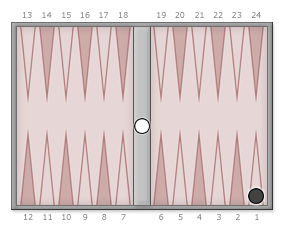 | 1 v bar: Black to roll |
The overlap formula says this position has contact because 1 + 25 = 26 which is greater than 25. But is there really contact here?
Black can’t hit because white’s only checker is on the bar. And white can’t hit because the game will be over before he even gets a chance to roll. There is no way for either side to hit or block the other, ever. There is “no possible contact” in this position.
No Practical Contact
How about this position?
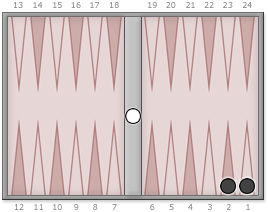 | 2,1 v bar: Black to roll |
At first this looks like the previous position. Black never hits white and white never hits black, so there is no contact here . . . or is there?
Suppose black rolls 2-1 but instead of taking two checkers off, he plays his 1 first, moving 2/1 and then uses his 2 to take off a checker. That leaves a black blot on the ace point which white can hit. This game is not necessarily over!
But really. Nobody is ever going to play a 2-1 this way. For all practical purposes, this game is over. I call this “no practical contact.”
No Significant Contact
Here is a position where there can still be hitting but the hitting has no effect on the outcome of the game.
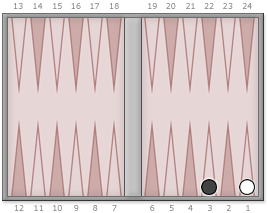 | 3 v 24: Black to roll |
If black rolls 2-1, it doesn’t matter whether he hits white’s checker on his way bearing off or not. The result is the same either way — black wins the game.
There can still be hitting in this game, but the hitting is of no consequence. Positions like this have “no significant contact” because whatever contact they have is has no affect on the outcome of the game.
Block-Only Contact
There is another interesting type of contact. The only examples from hypergammon have no significant contact, so let me give an example from backgammon.
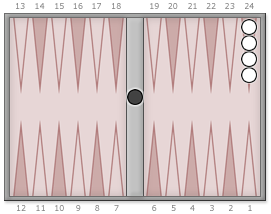 | bar v 1x4: Black to roll |
There is no hitting left in this game: White can’t hit because black is on the bar and black can’t hit because white always has an even number of checkers on his ace point.
What about blocking? Consider this scenario: Black rolls 1-1 and dances; white rolls and takes two checkers off; black rolls 6-6 and enters; white rolls and wins the game.
If black’s original 1-1 roll hadn’t been blocked, the game would have been different. If black had been able to enter with his 1-1, then his subsequent 6-6 would have won him the game. There is blocking left in this game and it comes into play when black rolls 1-1 followed by 6-6.
Which Positions Have Contact?
Last time, I gave a ten positions and asked which ones have contact and which do not.
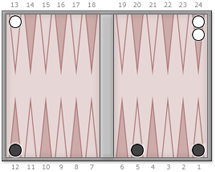 a. 12 v 12 | 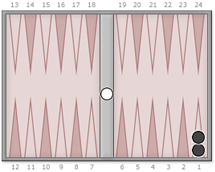 b. 1,1 v bar |
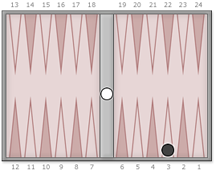 c. 3 v bar | 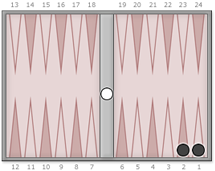 d. 2,1 v bar |
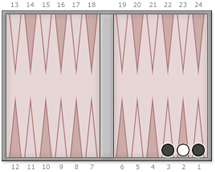 e. 3,1 v 23 | 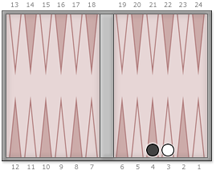 f. 4 v 22 |
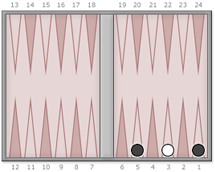 g. 5,1 v 22 | 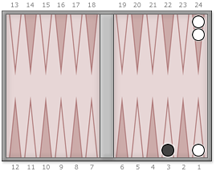 h. 3 v 24,1,1 |
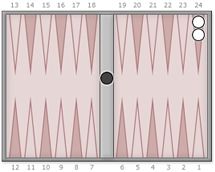 i. bar v 1,1 | 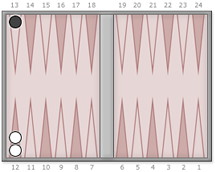 j. 13 v 13,13 |
Here are my answers according to the different definitions of contact I gave earlier.
| Overlap | Possible | Practical | Blk-Only | Significant | ||
| a. | 12 v 12 | N | N | N | N | N |
| b. | 1,1 v bar | Y | N | N | N | N |
| c. | 3 v bar | Y | N | N | N | N |
| d. | 2,1 v bar | Y | Y | N | N | N |
| e. | 3,1 v 23 | Y | Y | N | N | N |
| f. | 4 v 22 | Y | Y | N | N | N |
| g. | 5,1 v 22 | Y | Y | N | N | N |
| h. | 3 v 24,1,1 | Y | Y | Y | N | N |
| i. | bar v 1,1 | Y | Y | Y | Y | N |
| j. | 13 v 13,13 | Y | Y | Y | Y | Y |
Measuring Contact
Is it possible to measure how much contact a position has? It seems it should be. A game that is likely to see a lot of hitting and blocking could be considered to have a lot of contact, and a position that rarely sees any hitting or blocking could be said to have very little contact.
With that in mind, let me ask:
- What position in hypergammon has the most contact?
- What position in hypergammon has the least contact (excluding positions that have no contact at all)?
Any ideas?